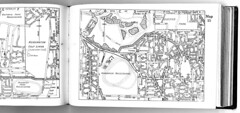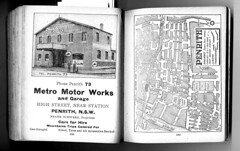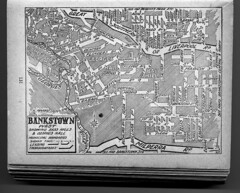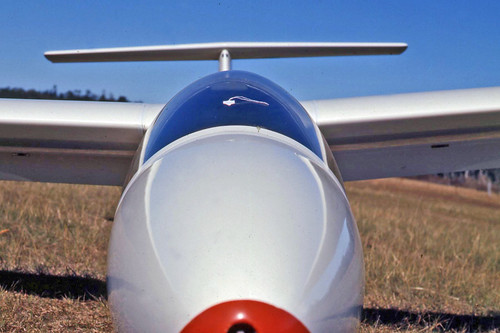Not exactly Sydney but close enough and inextricably linked both now and in the past... there's an excellent heritage walk on the Gosford Council website but it lacks a few current maps and images... so here are some excerpts with Google Maps and Streetview images added.... and remember to check out the GCC site for additional detail (including some marvellous old photos).
Mann Street South Heritage Walk — Gosford City Council

Mann Street South Heritage Walk — Gosford City Council
Gosford Park was dedicated on 15th January 1886. At that time the Park was a bare paddock. A rotunda for band recitals was added much later. This Park sat directly above Brisbane Water in the early days. The land immediately below the Park is all reclaimed from Brisbane Water. The practice ovals at the rear of the 1954 Gosford Public School were once all part of Brisbane Water. Georgiana Terrace marks the northernmost place Brisbane Water once reached. Around 1911, spoil from dredges was piled up on the water's edge, to create "Waterside Park". Later projects led to further reclamation and the building of Dane Drive. Vaughan Avenue was once named Wharf Street.Mann Street South Heritage Walk — Gosford City Council
This part of Mann Street was once comparatively busy, with a conveniently located pub and General Store waiting for travellers to and from Sydney, and a Post and Telegraph Office. Steamship travel was the fastest and most comfortable means of getting to Gosford prior to the coming of the railway in 1887. George Watt sold tickets for the Parramatta River Steam Company from his two-storey weatherboard building. Watt's Gosford Emporium sold boots and shoes, ironmongery and crockery, groceries, drapery, meat safes and scrubbing boards amongst other things. With the railway station being built further north along Mann Street, during the 1880s, the businesses began to gravitate towards it.Mann Street South Heritage Walk — Gosford City Council
A casual look at the front of this building (which a late friend described as " late 20th century brutalist!) would lead you might think that there was nothing historic about it at all. Walk to the northern end, and look east. You will see that the awful red brick front of the building hides a largely intact Victorian building. Along Mann Street there are some lovely old buildings hidden behind very unflattering 1950s & 60s facades.Mann Street South Heritage Walk — Gosford City Council
The Post and Telegraph Office, and adjacent residence, were originally long and low single storey structures designed by James Barnet. In 1891 a second storey was added to the main Post Office. The building has had further alterations from 1908 to 1953, culminating in the building you see before you.
looking west directly across the street is the site of the Old Gosford School of Arts. Built in 1888, the Gosford community was very proud of this building. It featured a library, reading room, large meeting room, Municipal Chambers and a hall capable of seating 250 people. Travelling theatrical companies, magicians, illusionists and a blind concert group gave concerts in the hall. Travelling picture showmen would bring their wares to the people before the establishment of permanent cinemas in town. In 1927 the School of Arts burnt down. The hall was rebuilt on the old foundations. On the northern side facing Georgiana Terrace can be seen remnants of the old painted signage for Council offices. It is now used as a teachers' resource centre.Mann Street South Heritage Walk — Gosford City Council
The original Gosford watch-house was built in Donnison Street in 1827, near today's Workcover building site. It was a three-roomed shingle-roofed slab timber structure that quickly became inadequate for its purpose. Around 1833 the first Gosford courthouse was added.Mann Street South Heritage Walk — Gosford City Council
In 1849 the "new' Gosford Court and Police Station was built in Mann Street. It cost 345 pounds, and consisted of a courthouse, clerk's room, magistrate's room, two cells, a constable's room, and a yard. By the mid 1860s the building was in need of major repair. The northern end of the complex was extended in 1892. A brick charge room and offices were added in 1928 to the southern end. If you look closely you can see evidence of the various additions. From Georgiana Terrace you can see the original gaol cells. Over the front entrance you can still see the wrought-iron gas lamp holder. In the 1970s, police working in the old station were fed up with outdated facilities. Plans for the demolition of the building were halted, and a variety of historical and arts groups put their hands up to occupy the site. The new Gosford Police Centre was opened in June 1983. The new courthouse in Donnison Street opened in August 1987.
Henry Helman designed the Brisbane Water County Council building that was completed in 1957. The town was very proud of the project, and it featured local sandstone fascia provided by Gosford Quarries, and many fittings and furnishings from local companies. The meeting rooms were wood panelled, and the mechanism for operating the clock tower was controlled from a bookcase shaped to reflect the design of the outer building and clock tower. The old County Council building was briefly the home of the Northern Eagles football team in the late 1990s. The Spurbest proposal for the site includes the retention of the County Council facade.Mann Street South Heritage Walk — Gosford City Council
The number and longevity of cafes in town reflect the passing trade in tourists and travellers who used to be directed through Gosford along the old Pacific Highway. PNA House stands on Jephson's Corner. Horace Jephson was a tobacconist and hairdresser who built his store on the site in 1907. A later extension was added in 1913. Walter Buscombe was an early occupant of the site before Jephson. Fred Cohen had a drapery and grocery store next door in the early 1910s. Old photos show that these two buildings were rather lovely in their time.Mann Street South Heritage Walk — Gosford City Council
the Imperial Centre now stands on Sterland's Corner.Mann Street South Heritage Walk — Gosford City Council
Shepherd's Corner was where William Street meets Mann StreetMann Street South Heritage Walk — Gosford City Council
Where the Commonwealth Bank stands today was known as Hill's Corner. The corner was previously known as Campbell's Corner, after the owner of shops in the 1910s. Campbell's shops were destroyed by fire in November 1914. Campbell rebuilt on the site, and soon after sold to Hill. Hill's Corner Chambers were notable as the first "modern" mix of shops, businesses and professional rooms, with three-way garage. Fire destroyed the building in November 1933.Mann Street South Heritage Walk — Gosford City Council
In 1937 a new and luxurious theatre, the Regal, was opened. It was designed in the Art Deco/Moderne style, and was as good as any city cinema of the period. The opening programme was the Janet Gaynor and Frederic March movie A Star is Born. Local workmen were used on the theatre that featured "plate glass and polished maple doors", "a foyer of terrazzo", 20,000 pounds worth of RCA sound equipment, and a "crying room" where mothers and infants could enjoy films without disturbing other patrons.
My list of Sydney's race tracks and circuits.
or checkout my list of Sydney and surrounding airstrips and airports. 





























